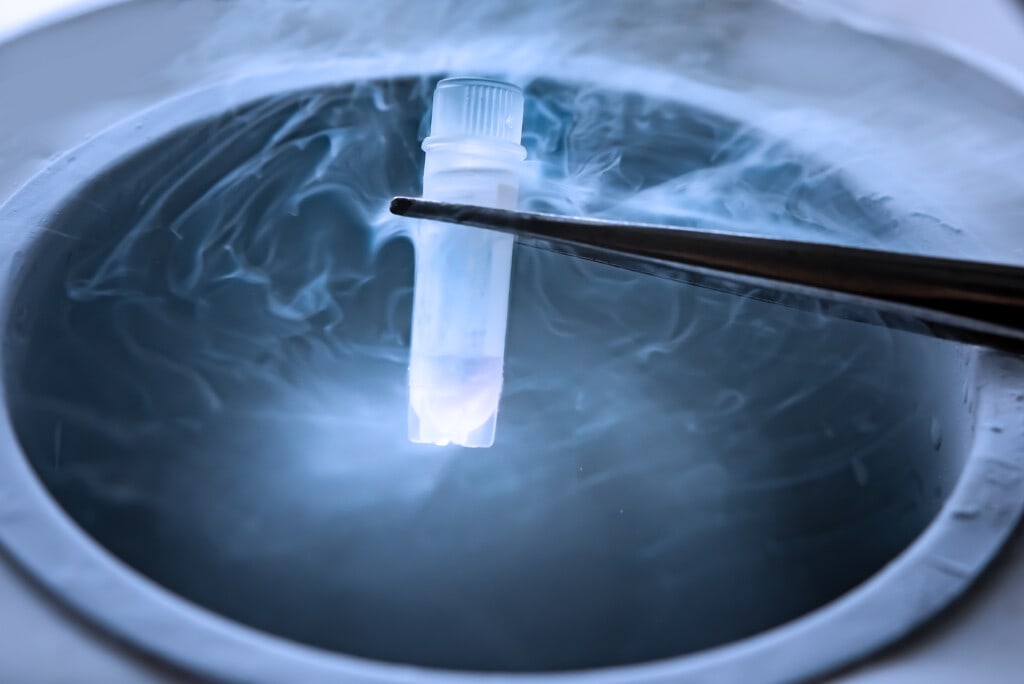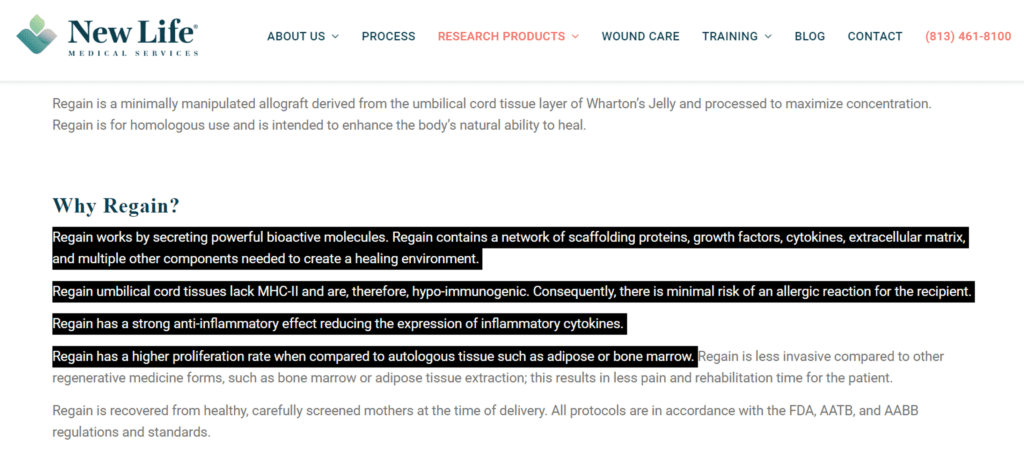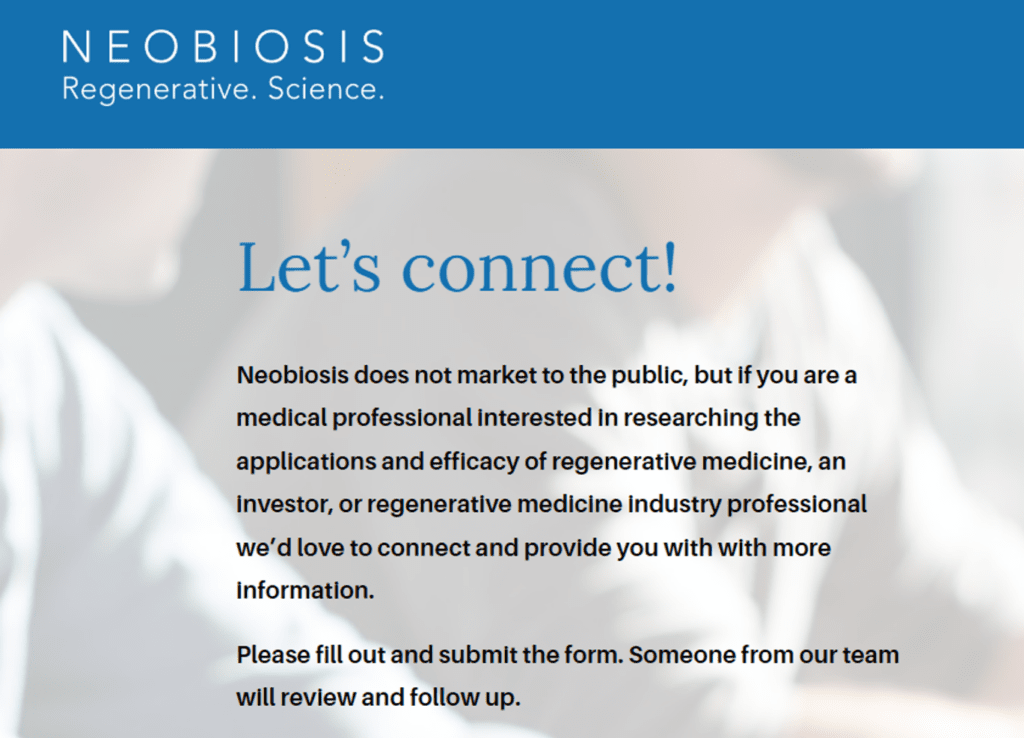Umbilical Cord “Stem Cells”, Harry Aldeson, and the Business of Medicine

Credit: Shutterstock
I’ve blogged several times about an ND in Utah named Harry Adelson. Harry, IMHO, has always pushed the edge of the regenerative medicine space, not in a good way. I was recently forwarded an advertising email sent by his Docere Clinic that caught my attention because it makes the same claim that our lab and others have debunked multiple times. So today, we’ll review that claim through the lens of businessmen and doctors.
Businessmen and Doctors
I break medical providers in the new field of interventional orthobiologics into two categories: businessmen and doctors. While being called a good businessman in most circles is a compliment, it’s often a two-edged sword in medical care. For example, a doctor has limits on how much they can push the entrepreneurial envelope because they’re grounded by a duty to put the patient’s best interests over their own.
I believe a medical businessman exploits regenerative medicine’s potential to maximize revenue at every turn, and as a result, they tend to overpromise and underdeliver. They don’t collect or publish data because that costs money and reduces the bottom line. They also generally ignore the evolving science because that reduces the profit potential. They often have no issues telling patients whatever they want to hear, so that means that nearly everyone who walks through the door and can pay is a candidate for an interventional orthobiologics procedure.
Doctors are different. While they enjoy making money like anyone else, there is a duty to the patient; hence they tend to soft sell what regenerative medicine can do, which reduces the profit potential. They tend to underpromise and overdeliver. They collect or publish data, even though that costs money and reduces the bottom line. They follow the evolving science which forces them to play within guardrails that often reduces the profit potential. They never tell patients whatever they want to hear, meaning some patients who walk through the door are not candidates for an interventional orthobiologics procedure, despite the lost opportunity cost.
In summary, businessmen take more from the field than they give, and doctors give more to the field than they take. So let’s review this new claim made by Docere Clinic through that lens. Is Harry behaving like a businessman or a doctor?
NDs and Regenerative Medicine
Before we jump into this analysis, let’s discuss the difference between an ND (Naturopathic Doctor) and an MD/DO physician. Naturopaths receive just a small fraction of specialist medical doctors’ training. In addition, almost all of that training is in well-care and not in recognizing and treating complications. Hence, I and many others have raised the alarm about a new and disturbing trend where naturopaths perform complex injection procedures that often surpass their legally granted scope of practice.
It’s also worth mentioning that years ago, I blogged on Harry and shared my opinions that he was running afoul of the Utah naturopathic practice act by performing procedures like bone marrow aspiration, liposuction, and intradiscal spine procedures. Before I could turn around, Harry sued me. Thankfully we hired a top 10 first amendment lawyer who got Harry’s case thrown out with prejudice.
Docere’s New Claims
Harry sent a newsletter update on his Full Body Stem Cell Makeover®. This is a procedure where he injects many different areas that I have previously described as problematic for various reasons. Harry’s old standby orthobiologic for this procedure used to be bone marrow, but his newsletter describes some changes:
“We Are Now Offering The Use of Allogeneic Stem Cells (aka Umbilical Cord Stem Cells)”
Harry goes on to describe an intensive vetting process:
“The next step was finding a lab that processes umbilical cord cells to work with. Up to this point, my experience had been that there are basically two types of labs; 1) the “Ivory Tower” type that are highly reputable but will only open accounts with University Medical Programs conducting NIH-funded research but not with private practice docs, and 2) labs that will open accounts with anyone, but I wouldn’t trust their products.
After a lot of digging around the industry and speaking with people I know and trust, I was introduced to New Life Regenerative Medicine and their partner, Neobiosis. These labs have stellar reputations, are FDA registered, and work closely with the FDA on continued excellence.”
So just how complete and thorough was this vetting process? After all, Harry is making the massive claim that the two companies highlighted above are supplying him with living and viable umbilical cord stem cells. Is that claim grounded in medical science, or is it business hype?
How Likely Is It that Harry Is Using Living and Viable Umbilical Cord Stem Cells?
Remember, if we’re going to classify Harry, we must examine whether his claims are real or just hyperbole. After all, in my direct experience, a medical businessman will often exaggerate to make a sale.
For those that read this blog, you know that back in the day, I had sales reps coming to our office wanting to sell me vials of amniotic or umbilical cord “stem cells.” Rather than take their word for it, since this sounded too good to be true, we tested those vials in our lab and found no living stem cells (1). That cost us real money and reduced our bottom line, but it was the right thing to do for the field. Then others began publishing the same findings, and finally, we worked with the CSU Translational Medicine Institute to publish a paper on umbilical cord “stem cells” in the world’s top orthopedic journal, which again showed that all of the tested products that claimed to have living stem cells contained dead and dying cells instead (2-4).
How could these sales reps and companies bottling amniotic fluid, cord blood, and Wharton’s Jelly be so wrong about what’s in their products? The companies only usually perform simple live/dead stains, which any stem cell scientist would know were not enough, as while they may show that 60% of the cells were alive on thaw, those cells are dying within hours. Why is this happening? There is no practical way to stick birth tissue in vials, process that material, bottle it, freeze it, store and then ship these vials, and shock thaw them at the bedside and end up with a viable and functional stem cell product. Forget about the fact that the claim of viable stem cells being sold with a tissue registration runs afoul of FDA regulations.
Could Harry, despite these scientific papers published in peer-reviewed medical journals and without publishing any of his own research contradicting what’s out there, have found a workaround here and is somehow offering real umbilical cord stem cells that are FDA compliant? Let’s explore that more by exploring the two players supplying “stem cells” for his Full Body Stem Cell Makeover®.
New Life Medical Services
I blogged on New Life Medical Services (Regenerative Medicine) in 2019. Back then, a business consultant was selling training for chiropractors on how to become a stem cell millionaire. That meant buying his magic vials of umbilical cord stem cells sold by New Life. I called the CEO of that company and got her to admit:
- The company was unwilling to state that their umbilical cord products had any living mesenchymal stem cells.
- Their products were just names, meaning the source of that product could be a different white-labeled source product from month to month.
New Life was a middleman distributor of other products and not a manufacturer. A current FDA Tissue Registration lookup shows that this designation hasn’t changed.
Problematic New Life Marketing
When looking up New Life’s products on their website, for the Wharton’s Jelly product, we see this:

This is, IMHO, a few sandwiches short of a proper regulatory picnic, and it also goes against the published research. First, a tissue registration product has not undergone any FDA review of claims through clinical trials and instead uses a quickie 45-minute online form. Hence its distributor can’t claim to sell living cells that have an effect on the human body. Despite that, we see the following:
- Regain is dependent on living cells because only living cells secrete things.
- Regain has a strong anti-inflammatory effect and reduces the expression of inflammatory cytokines. This is a mechanism of action claim that would need FDA scientific scrutiny before being able to make it.
- Regain grows in culture, which is another claim that it is a living cell product.
That last claim is interesting, as IMHO, our published data on six companies all claiming to sell umbilical cord stem cell products but all having no ability to survive to culture means that it is, more likely than not, a false claim.
What is NeoBiosis?
I immediately recognized the lead player at NeoBiosis as Ian White, Ph.D. If you read this blog, you know Ian from my 2018 blog on his last company, BioFirma. This company was connected to a chiropractic network selling umbilical cord stem cell therapies called IMAC. At the time, Ian claimed to lead the Translational Ocular Regenerative Medicine Unit at the University of Miami’s Bascom Palmer Eye Institute. However, I could never confirm that he even worked there, let alone led a research unit. IMAC claimed Ian worked at the “Interdisciplinary Stem Cells Institute” at UM. However, I couldn’t confirm that either. Near as I could tell, Ian was likely a lowly post-doc and not a major muckety muck at UM. Ian’s current bio on the Neobiosis website omits some of this prior information.
The NeoBiosis website states:
“Neobiosis is a biotechnology company focused on the development and manufacturing of innovative perinatal products for research and clinical trials.”
Hence, at first blush, Neobiosis doesn’t appear to sell commercial products for treatment, as Dr. Adelson claims. However, there is a form that you can fill out that says:

That’s odd. I’ve never seen a manufacturer of products for FDA clinical trials state that if you are a medical professional interested in performing research fill out this form. Why? Because that research requires an FDA IND for this type of project, which costs big bucks to obtain, so that’s generally outside of the budget of medical professionals. I called the company and spoke to an employee who told me they were changing their website when I pressed them on the Dr. Adelson e-mail. In other words, when I asked how they could only supply products to FDA clinical researchers when Dr. Adelson was advertising their product as part of a commercial cash procedure, they backed off the existing website “research-only” claim.
Given that our research team has published the world’s most authoritative paper on whether what Neobiosis is selling could contain living and functional mesenchymal stem cells, how likely is it that Harry’s claim is true? IMHO, there’s a slim to none chance that Harry’s claim about what he’s buying from Neobiosis can be backed up with any sophisticated science.
Summary
Based on the peer-reviewed literature, the umbilical cord stem cells claim is, IMHO, hyperbole. So what category does that put Harry in? If this were five years ago, before anyone knew much about what was in these products, he would be in the same category as the countless gullible providers who bought this song and dance and who should have known better. However, now that we have had multiple publications showing that it’s consumer fraud (in my opinion) to make this claim, he’s firmly in the medical businessman camp. It should also be noted that countless FDA letters have been sent to medical providers and distributors who have made this same claim (letter 1, letter 2, letter 3, letter4 , letter 5, and letter 6). So Harry would have to be living under a rock not to understand that making this claim is painting a big red regulatory action target on his back.
The upshot? I thought everyone claiming dead and dying umbilical cord tissue was a stem cell product had learned their lesson. I guess I was wrong. This will be interesting to see what the FDA does with Harry’s new advertising.
_______________________________________________________________
References:
(1) Berger D, Lyons N, Steinmetz, N. In Vitro Evaluation of Injectable, Placental Tissue-Derived Products for Interventional Orthopedics. Interventional Orthopedics Foundation Annual Meeting. Denver, 2015. https://interventionalorthopedics.org/wp-content/uploads/2017/08/AmnioProducts-Poster.pdf
(2) Panero AJ, Hirahara AM, Andersen WJ, Rothenberg J, Fierro F. Are Amniotic Fluid Products Stem Cell Therapies? A Study of Amniotic Fluid Preparations for Mesenchymal Stem Cells With Bone Marrow Comparison. Am J Sports Med. 2019 Apr;47(5):1230-1235. doi: 10.1177/0363546519829034. Epub 2019 Mar 7. PMID: 30844295.
(3) Becktell L, Matuska A, Hon S, Delco M, Cole B, Fortier L. Proteomic analysis and cell viability of nine amnion-derived biologics. Orthopedic Research Society Annual Meeting, New Orleans, 2018. https://app.box.com/s/vcx7uw17gupg9ki06i57lno1tbjmzwaf
(4) Berger DR, Centeno CJ, Kisiday JD, McIlwraith CW, Steinmetz NJ. Colony Forming Potential and Protein Composition of Commercial Umbilical Cord Allograft Products in Comparison With Autologous Orthobiologics. Am J Sports Med. 2021 Aug 16:3635465211031275. doi: 10.1177/03635465211031275. Epub ahead of print. PMID: 34398643.

NOTE: This blog post provides general information to help the reader better understand regenerative medicine, musculoskeletal health, and related subjects. All content provided in this blog, website, or any linked materials, including text, graphics, images, patient profiles, outcomes, and information, are not intended and should not be considered or used as a substitute for medical advice, diagnosis, or treatment. Please always consult with a professional and certified healthcare provider to discuss if a treatment is right for you.
